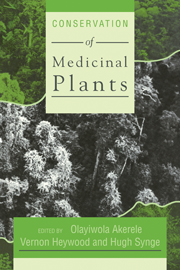Book contents
- Frontmatter
- Contents
- Contributors
- Preface
- Acknowledgements
- The Chiang Mai Declaration
- Introduction
- The Issue of Medicinal Plants
- Science, Industry and Medicinal Plants
- 6 Valuing the Biodiversity of Medicinal Plants
- 7 Economic Aspects of Exploitation of Medicinal Plants
- 8 Industry and the Conservation of Medicinal Plants
- 9 Information Systems and Databases for the Conservation of Medicinal Plants
- Techniques to Conserve Medicinal Plants
- Policies to Conserve Medicinal Plants
- Experiences from Programmes to Conserve Medicinal Plants
7 - Economic Aspects of Exploitation of Medicinal Plants
Published online by Cambridge University Press: 07 September 2010
- Frontmatter
- Contents
- Contributors
- Preface
- Acknowledgements
- The Chiang Mai Declaration
- Introduction
- The Issue of Medicinal Plants
- Science, Industry and Medicinal Plants
- 6 Valuing the Biodiversity of Medicinal Plants
- 7 Economic Aspects of Exploitation of Medicinal Plants
- 8 Industry and the Conservation of Medicinal Plants
- 9 Information Systems and Databases for the Conservation of Medicinal Plants
- Techniques to Conserve Medicinal Plants
- Policies to Conserve Medicinal Plants
- Experiences from Programmes to Conserve Medicinal Plants
Summary
Higher plants have been used as a source of drugs by mankind for several thousand years. In fact, ancient man was totally dependent on green plants for his day-to-day needs of medicaments. With the development of modern medicine, synthetic drugs and antibiotics, the importance of plants as raw material for drugs decreased considerably. However, plants were used as a source of some of the most important drugs, even in the modern system of medicine. With the advancement of synthetic organic chemistry most of the active constituents of plants used in medicine were synthesised. At one time it was thought that ultimately all the plant drugs would be obtained from synthetic sources. However, in spite of phenomenal development in the development of new drugs from synthetic sources and the appearance of antibiotics as major therapeutic agents, plants continue to provide basic raw materials for some of the most important drugs.
Although data are not available for all countries, a study carried out in the United States by Farnsworth and his colleagues between 1958 and 1980 indicated that although the number of prescriptions issued by community pharmacies in the United States increased considerably, the percentage of prescriptions containing one or more plant products remained constant at a figure of 25%. It has been found that in highly developed countries like the United States more than 100 chemical constituents of definite structure derived from 41 species of plants were used in modern medicine. It has also been estimated that in addition to these active constituents, more than 96 crude extracts were also used in the United States.
- Type
- Chapter
- Information
- Conservation of Medicinal Plants , pp. 125 - 140Publisher: Cambridge University PressPrint publication year: 1991
- 4
- Cited by



